WorldShare Acquisitions release notes, June 2021
Release Date: June 24, 2021
Introduction
This release of WorldShare Acquisitions provides two new features and enhancements in addition to numerous bug fixes. These features will help you manage more complex workflows, including:
- Enhanced support for bulk subscription renewal workflows
- Transfer of serials data for merged serial titles
- Search order items by currency and view the currency column
Many of these enhancements are the direct result of your feedback.
Recommended actions
For this release, we recommend that you review the following checklists and complete the relevant tasks so that you can adjust your policies and workflows and train your staff. These checklists identify updates that we have determined as significant for most institutions. We encourage you to review all of the items in the release notes to determine whether there are other items that might require additional action or follow-up by your institution.
Administrative actions
These items require immediate action or decisions.
| Action |
|---|
|
None at this time. |
Follow-up actions
In an effort to keep your staff informed of new features and changes, you may also want to consider these items.
| Action |
|---|
|
Note that when renewing items where the source currency does not match the target currency, the current exchange rate will be applied to the price of the item. |
New features and enhancements
Enhanced support for bulk subscription renewal workflows
There are a number of features this release that enhance the bulk subscription renewal process. Please use these features to more easily renew subscriptions that are ready for renewal.
Save renewal list settings when renewing the renewal list
If you renew a renewal list without first remembering to save the renewal list settings, the system will automatically save the renewal list settings for you. This prevents you from accidentally using the wrong renewal list settings when renewing items. Previously, if you forgot to save the renewal list settings before renewing, the renewal action would revert your renewal list settings to their previous state, potentially causing you to use the wrong renewal list settings. Now, the renewal list settings are automatically saved when you renew the renewal list.
To save a renewal list during renewing:
- Open a renewal list.
- Set your renewal list settings to the desired state.
- Click Actions > Renew item(s). Renewal list settings will be saved before your renewal list is renewed.
Refresh order items being renewed and fund mapping tables
If you navigate away from a renewal list and then back, the two tables on the page - the Order Items Being Renewed and Fund Mapping tables - will be refreshed with the latest information. This makes sure that you are looking at the most up-to-date information for your renewal list. Previously, you had to manually refresh these tables if you added new items to the renewal list while you were away from the renewal list page. Now, you can see any new items or funds in these tables when you return to the page, even if you do not manually refresh the tables.
To refresh the Order Items Being Renewed and Fund Mapping table:
- Open a renewal list.
- Navigate away from the renewal list.
- Add new item(s) to the renewal list.
- Navigate back to the renewal list. The Order Items Being Renewed table and Fund Mapping table are refreshed with new values.
Filter order items being renewed by start and end dates
Note: There are several known issues related to filtering order items being renewed by start date and end date. Please see the known issues section at the bottom of these release notes before you attempt to use this feature. These problems will be fixed in a July release.
You can now filter order items being renewed by their start and end dates. Among other things, this allows you to locate order items whose end date is not expiring this year (e.g. 2-year subscriptions) and remove these items from your renewal list. Previously, you could filter order items by start date and end date before adding them to a renewal list, but you could not filter order items added to a renewal list by start date and end date. Now, you can filter by these fields both before and after adding items to a renewal list.
To filter order items being renewed by start date and end date:
- Open a renewal list containing items with start and end dates.
- Open the Order Items Being Renewed accordion.
- Open the Start Date or End Date filters above the table.
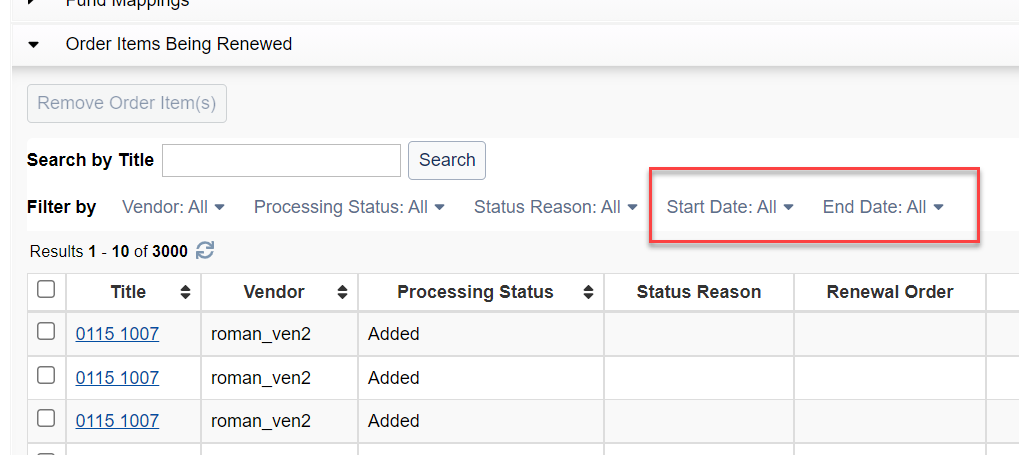
- Filter Start Date or End Date using one of the following filter options:
- More than _____ days ago
- More than _____ days from now
- Within the next _____ days
- From [date] to [date]
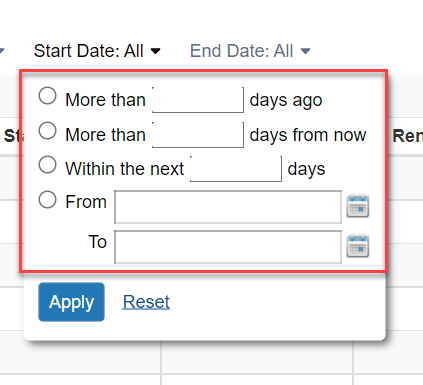
- Click Apply to apply these filters or Reset to clear all values from the filters.
- Additionally, you can view the Start Date and End Date values for each order item using the Start Date and End Date columns in the Order Items Being Renewed table.

Apply percentage increase to service charges
You can now apply the percentage increase used during the renewal of items to not only the unit price but to service charges as well. This allows you to predict a more accurate price for your renewal items. Previously, when you renewed items, the percentage increase was applied only to the unit price of the order items. But now, the percentage increase can be applied to the service charges as well using a new option under the Renewal List Settings.
To apply a percentage increase to service charges:
- Open a renewal list.
- Open the Renewal List Settings accordion.
- Under Price Increase, select the Apply percentage increase to service charges checkbox.
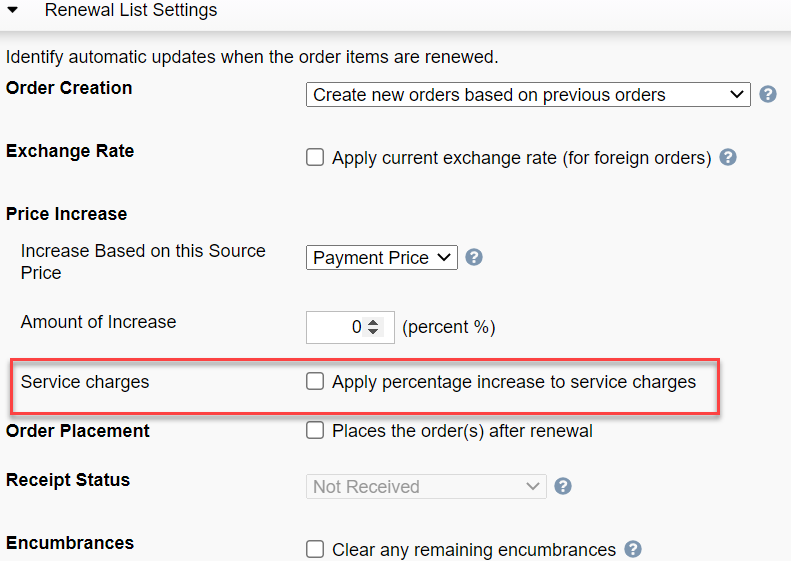
- Save the renewal list.
- Click Actions > Renew Order Item(s) to renew the renewal list. When calculating the service charges of the new item(s), the percentage increase will be applied to the source service charges as well.
Proper behavior when renewing items for vendors not in use
When renewing items from vendors that are no longer in use, the system now responds appropriately during the renewal of the renewal list. Previously, items for vendors that were not in use were being renewed as normal, with the vendor that was not in use selected as the vendor of the order. Now, for items using plan orders, the items are not renewed with the status reason Vendor for plan order is not in use. This is because plan orders require a vendor upon creation, and vendors that are not in use cannot be used for new orders. For items on purchase orders, the items are renewed but without a vendor for the order, and the items have the status Renewed with problems.
Transfer of data for merged serials titles
You can now transfer serials data from a serial title that has been merged to the new serial title. This allows you to keep receiving the new record using information from the old (merged) record, saving you the time of manually entering this data yourself. Previously, when a serial record was merged with another record, the serials information (e.g., most recent issue, publication pattern, and receiving status) still remained on the old record, and you had to manually recreate this information on the new record. Now, with just a few clicks, you can transfer all this existing data from the old (merged) record to the new serials record.
To transfer data from a merged serial to a new record:
- Search for the serial title under Discover Items. (If you search by the old OCLC Number, the new record will show up in the results.)
- Open the serial title in question by clicking on the title. You will be taken to the Issues section of the title.
- At the top of the page, you will see the following message: This serial record may have replaced another record that contained important receiving and/or prediction data. To transfer the data, click the Transfer Data button.
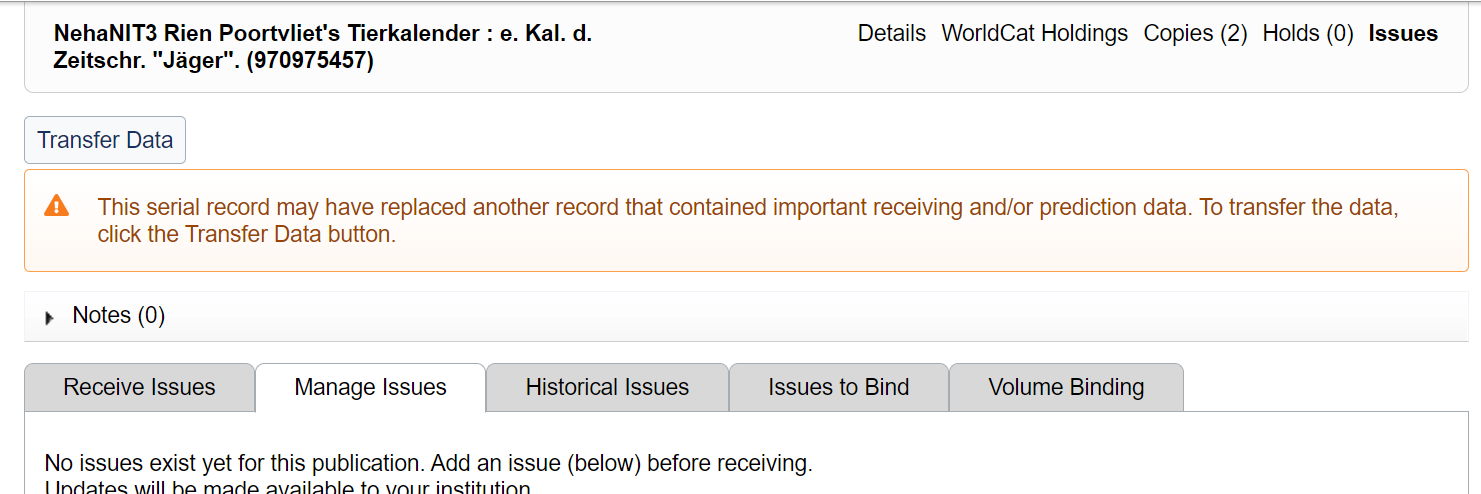
- Click the Transfer Data button. A dialog will appear on the screen.
- If there are multiple serial records that were merged into the current record, you will see an OCLC Number dropdown. This allows you to select from multiple records that were merged into this record. (This should happen very rarely.)
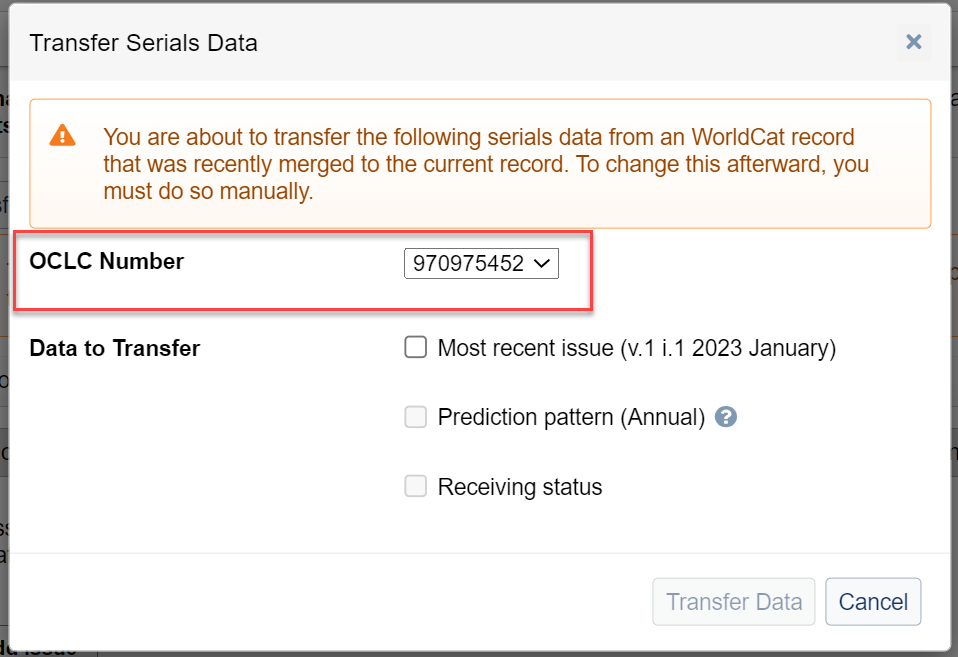
- There is also a Data to Transfer section. This will include one or more of the following options:
- Most recent issue:
- If the new record has no issues, you can transfer the most recent issue from the merged record to the new record.
- If the new record has no issues, you must transfer the most recent issue before you can transfer the prediction pattern or receiving status.
- Prediction pattern:
- If the new record has no prediction pattern, you can transfer the prediction pattern from the merged record to the new record.
- To transfer the pattern, either the new record must already have at least one issue, or you must select to transfer the most recent issue. If there are no issues on the new record, you must first select to transfer the most recent issue before the prediction pattern option is enabled.
- Receiving status:
- This is perhaps the most important element to be transferred. This is what determines whether issues of this title appear on your Missing Issues page.
- To transfer the receiving status, either the new record must already have at least one issue, or you must select to transfer the most recent issue. If there are no issues for the new record, you must first select to transfer the most recent issue before the receiving status option is enabled.

- Most recent issue:
- Once you have selected all the data you wish to transfer, click Transfer Data to complete the process and transfer the data to the new serial record.

Search order items by currency and view the currency column
You can now search order items by their currency. This allows you to know in advance what the currency of the order items are which you are adding to a renewal list. Previously, you could view the currency of the order on the order page, but you could not search order items by their currency. Now, you can both view the currency of an order item in the order item search and search by the currency of the order item.
To search order items by currency:
- Open the order item search (Orders > Order Items).
- Click on Filters to view all filters and select the Currency filter from the dropdown to enable.

- Click on the Currency filter and start typing either the name or abbreviation of currency you want to filter by. You can select one or multiple currencies from the list. Click Apply.
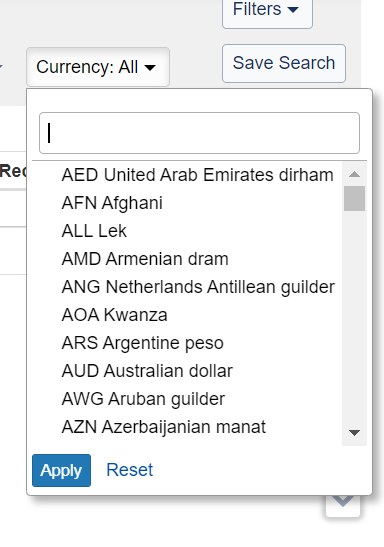
- To view the currency of an order item, click on the gear icon and click on the checkbox next to Currency. (Currency appears a quarter-way down the list after Order Name.)

- The currency column will display in the order items table immediately to the right of the Order Name column.
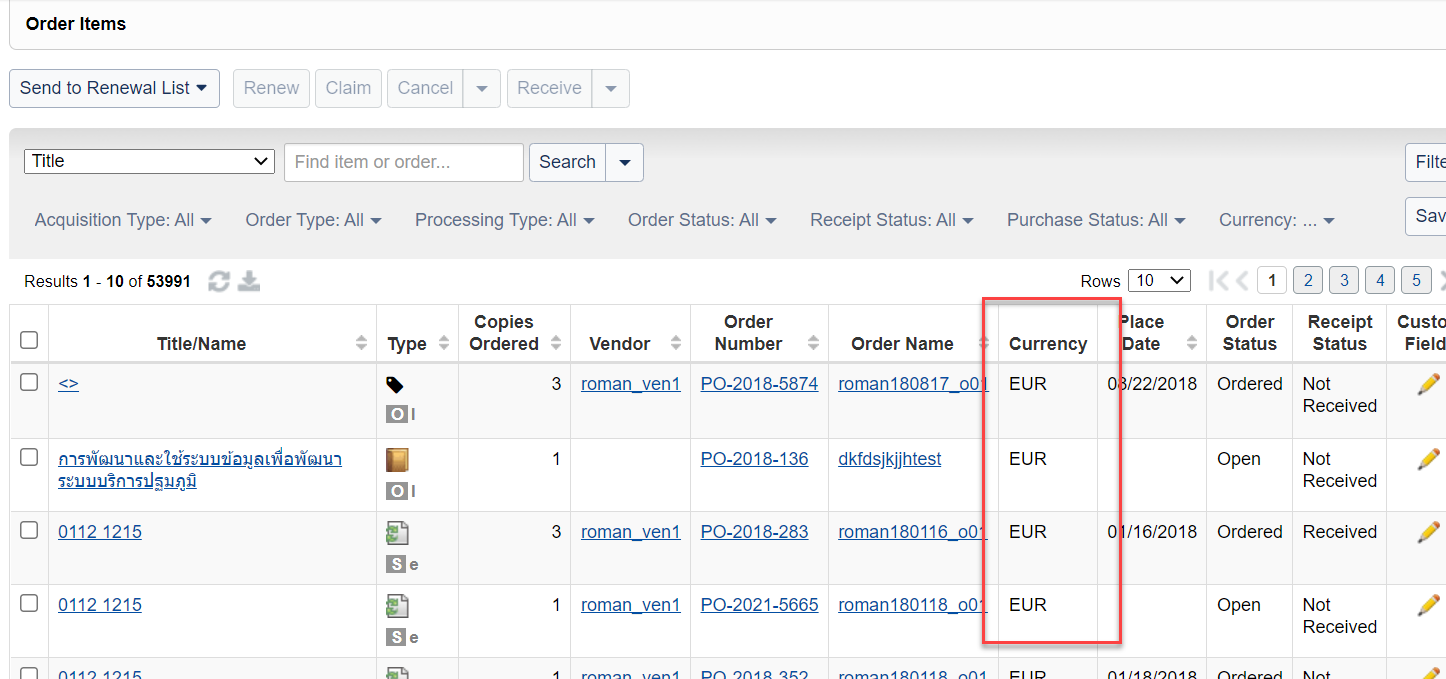
Bug fixes
EDIFACT Invoices with foreign currency can be imported
You can now import EDIFACT invoices using a foreign currency. Previously, if you attempted to import an EDIFACT invoice that specified a currency other than the institution's currency, the system would not import the invoice with the error "Unexpected error: Exchange range can not be null." Now, this error does not appear, and the invoice is imported with the currency specified in the EDIFACT invoice file.
Invoice paging works correctly when navigating to invoice from invoice item search
You can now page through the invoice items on an invoice even when opening the invoice via the invoice item search. Previously, if you opened an invoice by clicking on an item in the invoice item search, it would open the invoice correctly with the item in question highlighted. However, when you tried to navigate to a different page of the invoice, the invoice would stay on the same page. Now, paging through invoice items on the invoice works correctly even when coming from the invoice item search.
Automated jobs now return an error when file retrieval fails
You can now receive an error message as part of the e-mail notification for automated jobs when they fail to retrieve files from the FTP server. Previously, if the system could not retrieve a file from the FTP server due to a system error or lost connection, the system would still give you a success message in the e-mail notification. However, now, the system shows an error in the e-mail notification that lets you know the system failed to retrieve files and that you need to consult the logs.
Logs for imported order show the correct number of items in order when importing multiple orders
You can now see the correct number of items for each order in the logs for an imported order file. Previously, when you imported a MARC order file with multiple orders in it, the logs would show a record for each order detailing how many items were imported out of the total number of items in the order. However, for the number of items in the order, the system actually showed the total number of items in the file, rather than for the order. Now, the logs show the total number of items in each order, rather than in the file as a whole.
Known issues
Using from/to for start and end date filters first makes other filter options not work
If you use the from/to dates option under the start and end date filters and then use one of the other filter options, the other filter option will not work. Instead, it will return all results rather than the filtered results. If you click Reset after using the From/To options, you can then use one of the other filter options successfully.
Values entered for start date and end date filters are not erased
If you enter a value for the start date or end date filters on the Order Items Being Renewed table, these values cannot be completely erased except by using the Reset link. A minimum of one character will always remain entered until you reset the form using the Reset link. If you need to clear values from this form, please use the reset link for now.
More than filters for start date and end include the day entered
When using the more than options in the start date and end date filters on the Order Items Being Renewed table, the system will filter by more than or equal to this number of days, rather than just more than this number of days. When using one of the more than filters, please enter one day less than the number of days you want to use.
Important links
Support website(s)
Support information for this product and related products can be found at:
